两蛋白间的分子对接3—使用AlphaFold进行
原创两蛋白间的分子对接3—使用AlphaFold进行
原创
sheldor没耳朵
发布于 2025-04-08 15:38:54
发布于 2025-04-08 15:38:54
两蛋白间的分子对接3—使用AlphaFold进行
据说AlphaFold进行分子对接比传统的蛋白分子工具如zdock、hdock的对接效果更好。因为AlphaFold是柔性对接,而其他是刚性对接或者半柔性对接。这次学习使用AlphaFold进行分子对接,以NEDD4L和TKTL1分子对接为例。
1.获取NEDD4L和TKTL1的氨基酸序列
- Uniprot网站中获取NEDD4L氨基酸序列,可以直接复制。同理获取TKTL1的氨基酸序列,未展示。
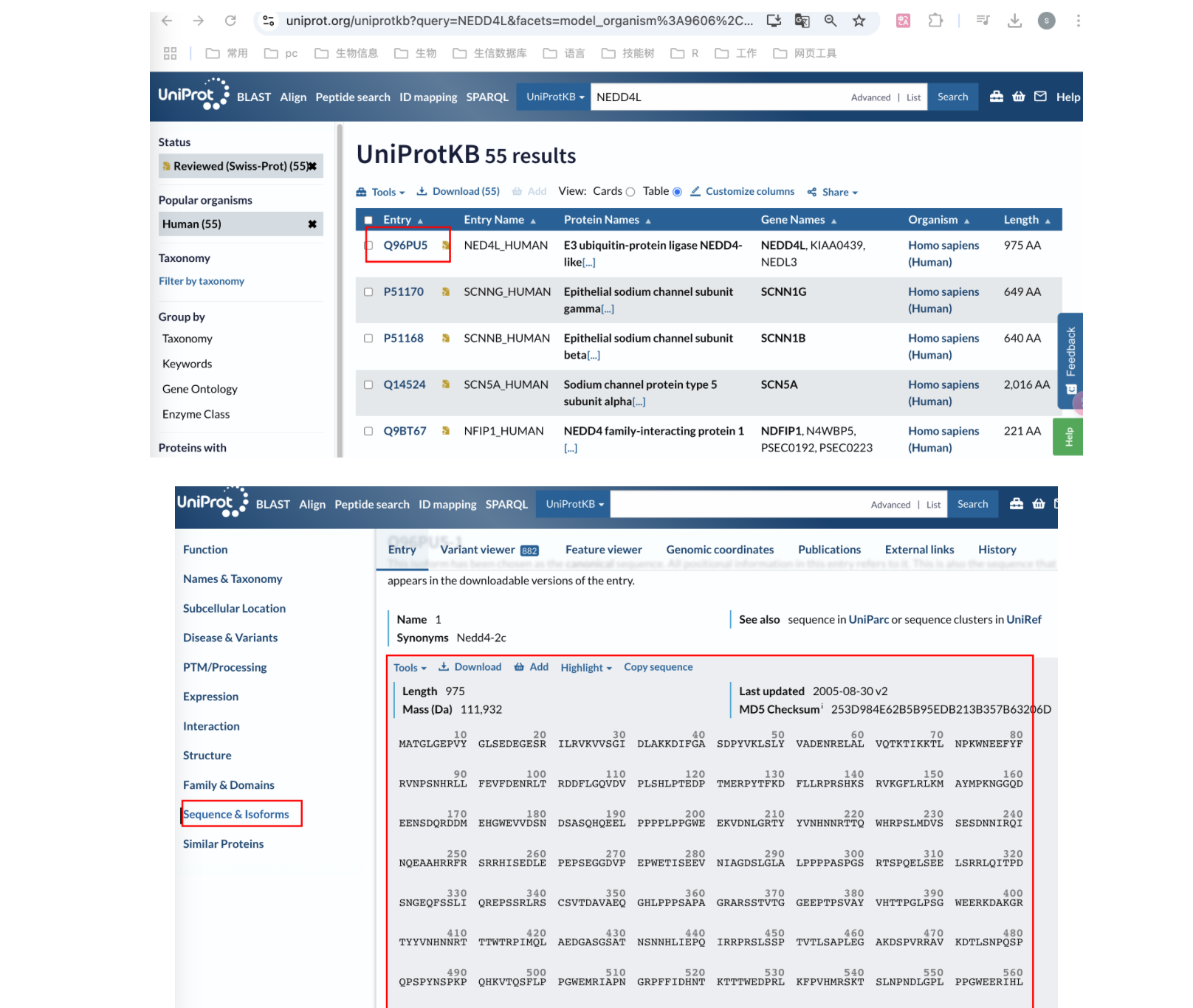
- 将分别将氨基酸序列复制到alphafold(https://alphafoldserver.com/)中,进行分子对接(注:需要google账户和科学上网)。点击提交,后重新命名,一般等待5min可以出结果
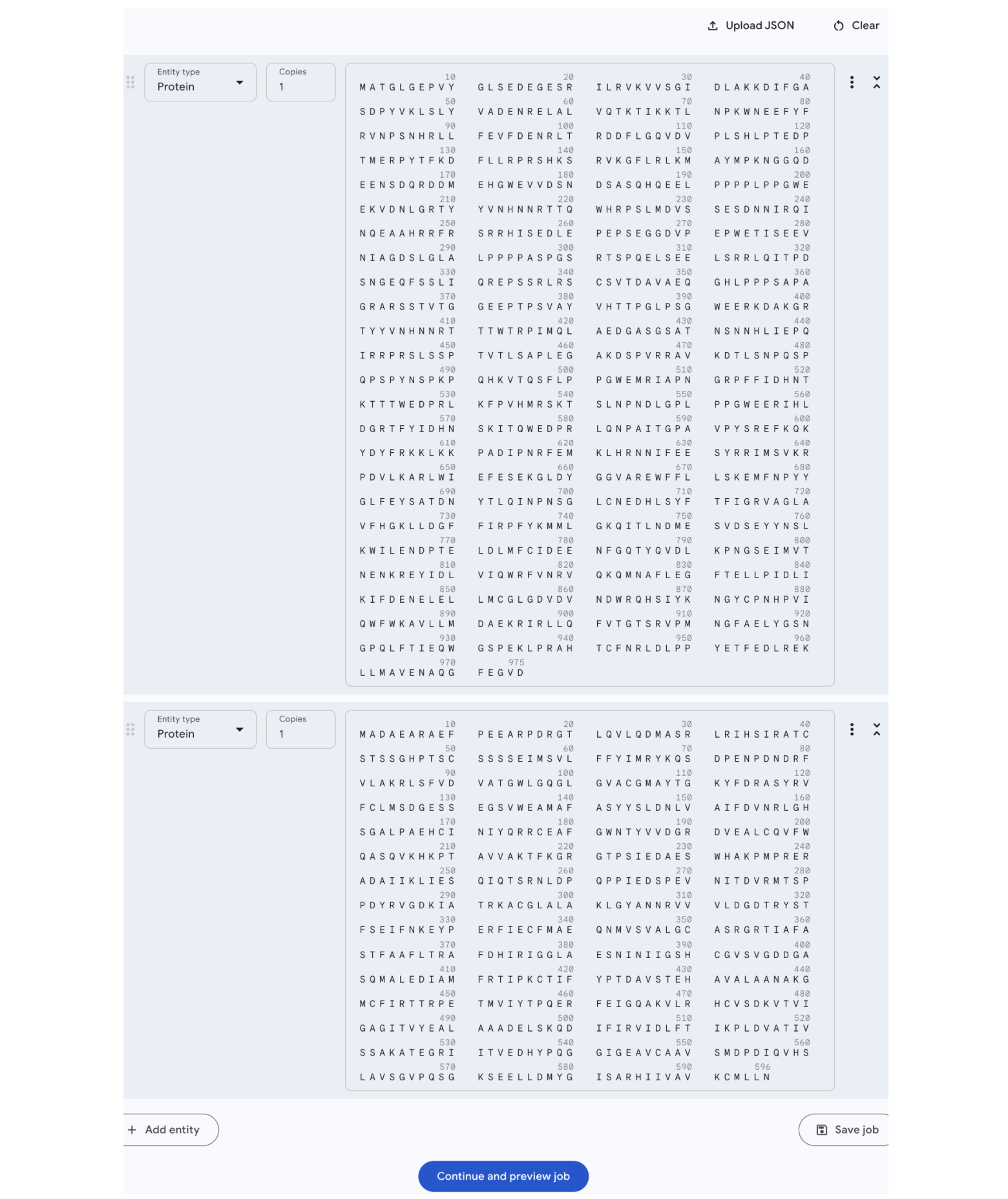
- 下载分子对接结果,选择top0进行后续处理和可视化
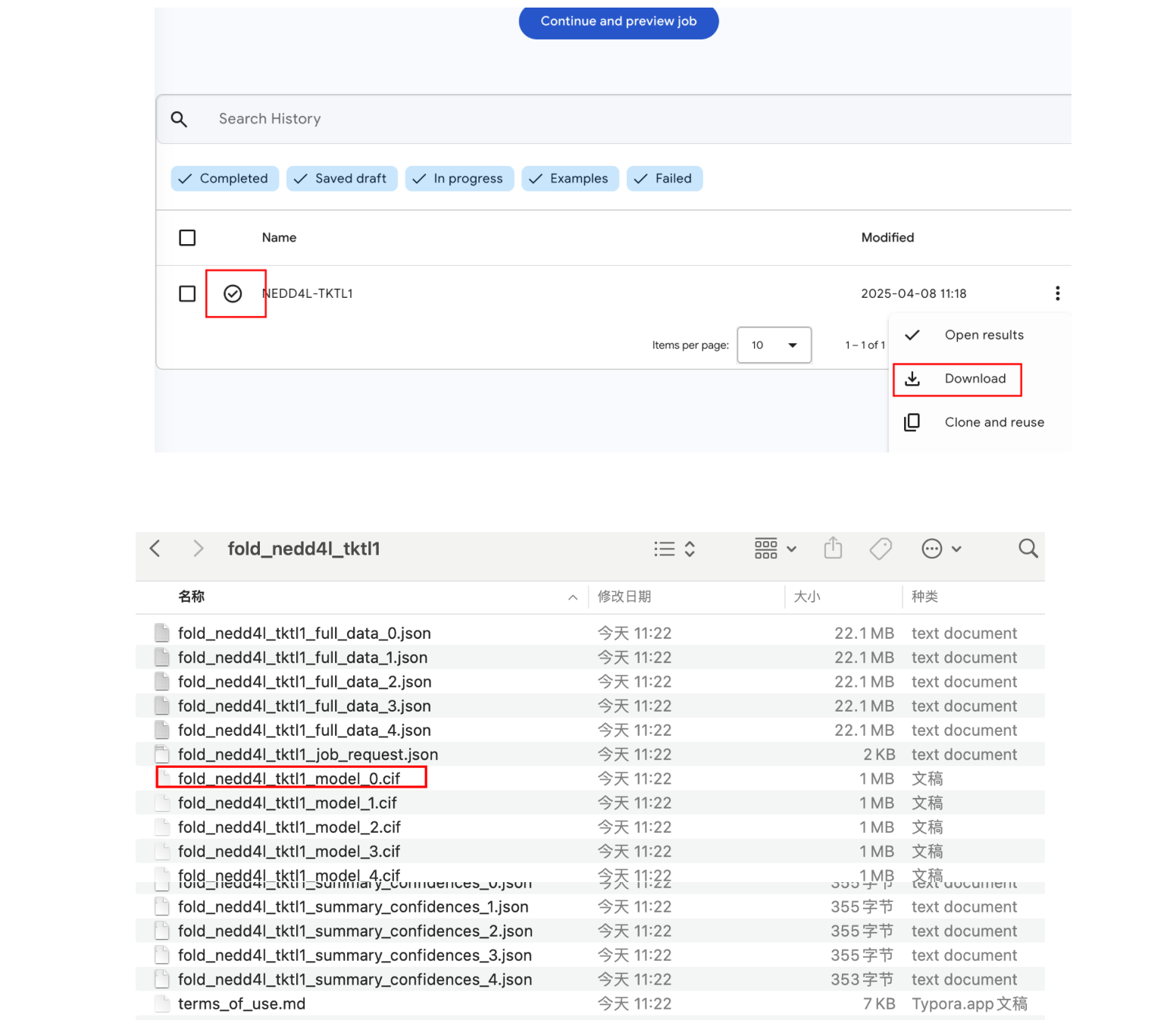
2.使用Maestro进行结构优化
- 将model 0 的文件直接拉到Maestro中(注意提前设置好工作目录),点击protein preparation workflow,点击run,进行加氢操作,结构优化等。提交完等待running结束即可
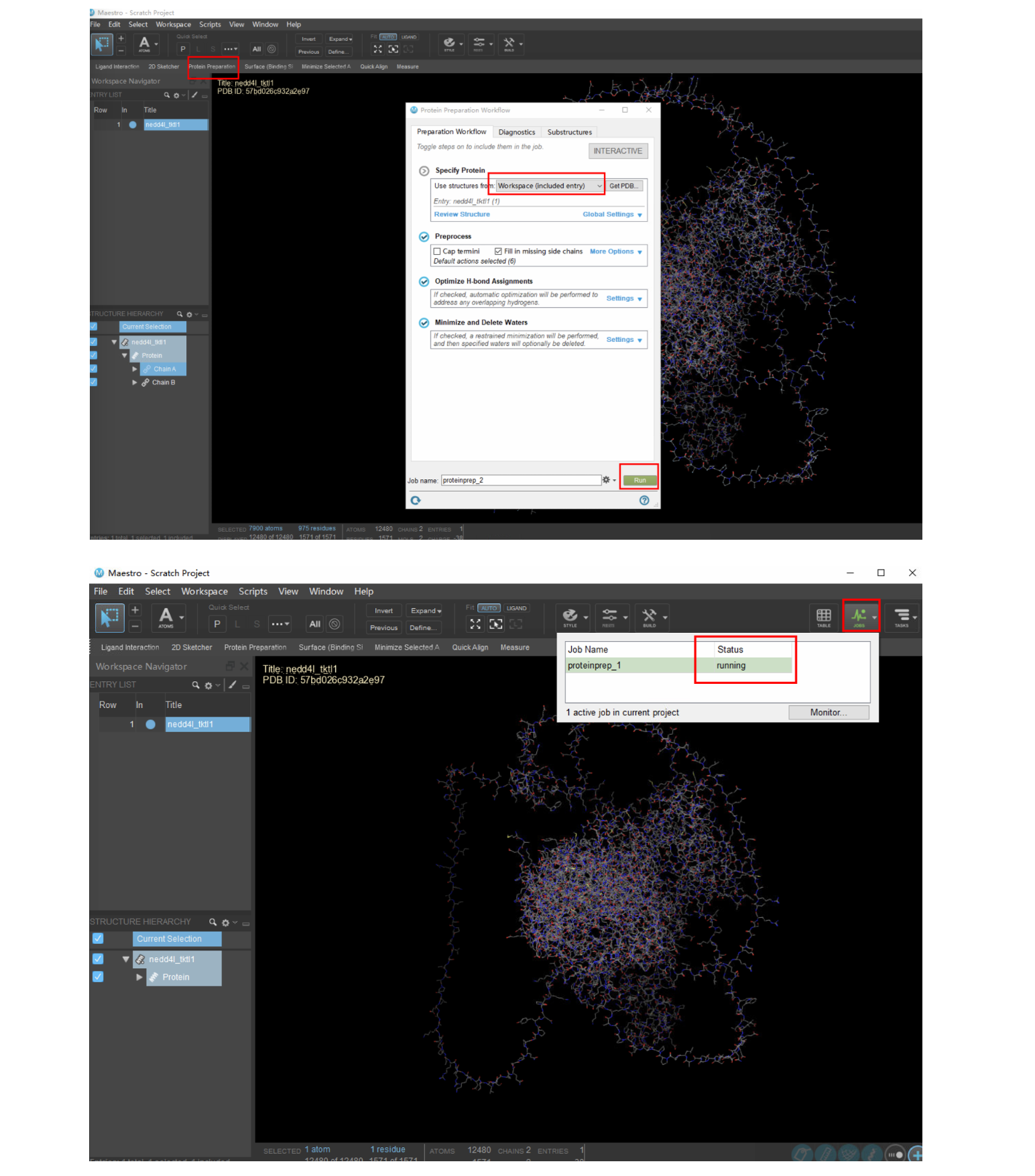
- 出现这个界面,表示优化已经完成。检查两个链条是否为chain A和chain B。否则需要更改为chain A和chain B,不然后续ppi.py脚本无法执行。输出PDB格式文件
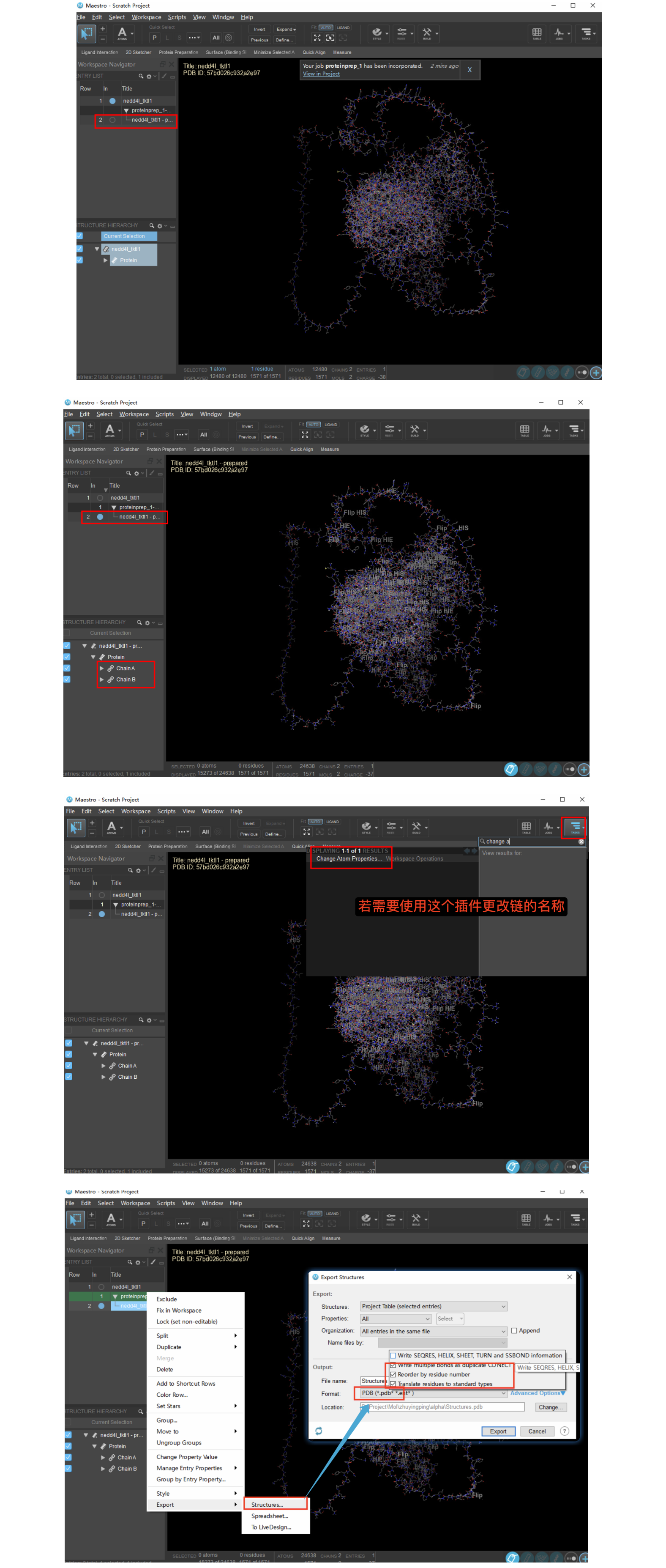
3.pymol中进行可视化操作
- 安装ppi.py脚本文件,Choose file选择ppi.py这个脚本,安装脚本
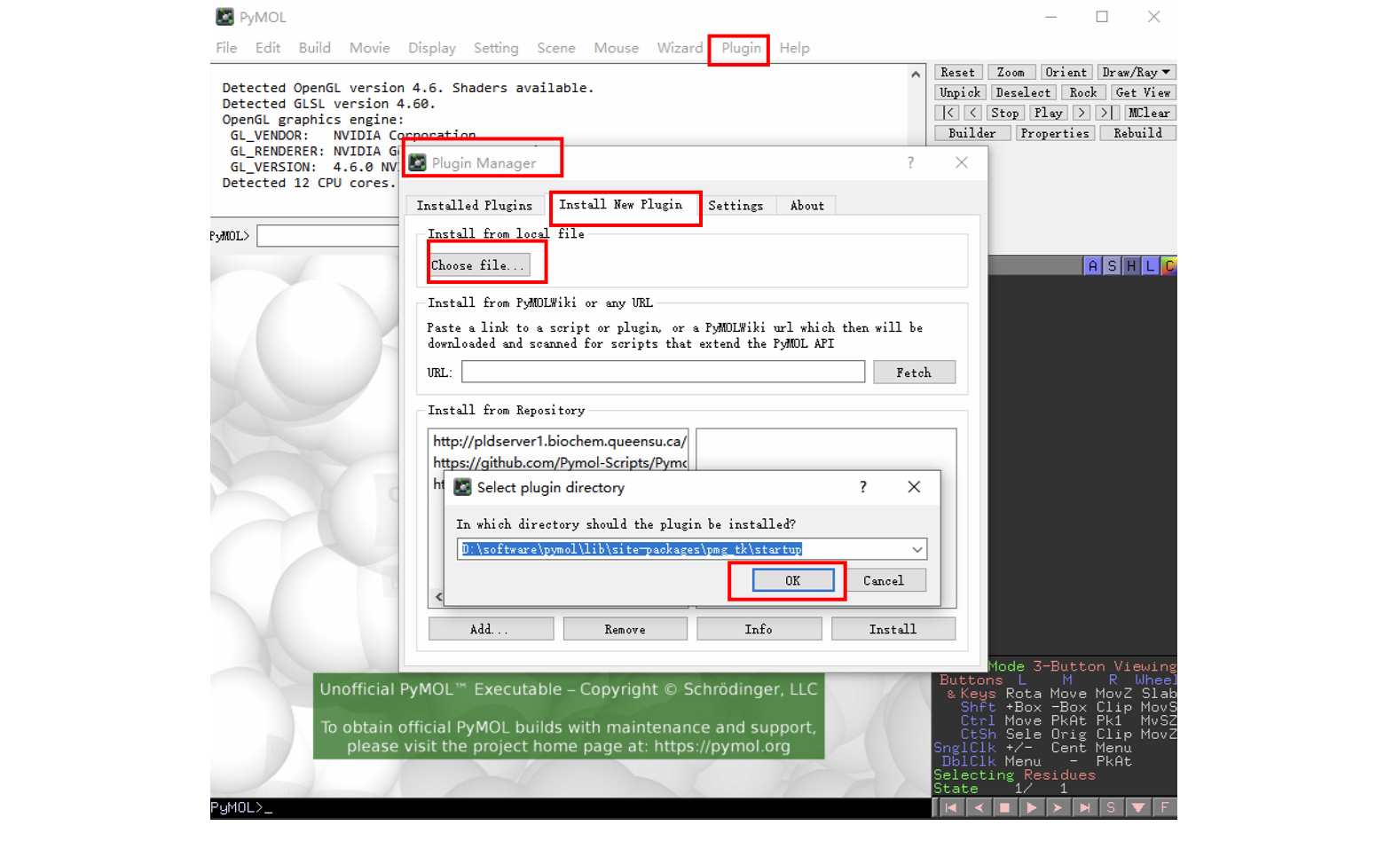
ppi.py
这段 Python 脚本是专门在 PyMOL 中执行的,用来分析和可视化蛋白质-蛋白质相互作用(PPI),重点包括:
- π-π stacking(芳香环之间的堆叠)
- Salt bridge(盐桥)
- Hydrogen bonds(氢键) 同时,脚本还设置了可视化参数,便于展示结果。
from pymol import cmd
from pymol.cmd import util
import sys
import os
import math
def pi_pi_angle(x1,x2,x3,y1,y2,y3):
import numpy as np
#print(x1,x2,x3,y1,y2,y3)
B1, B2, B3 = [x1[0] - x2[0], x1[1] - x2[1], x1[2] - x2[2]]
C1, C2, C3 = [x1[0] - x3[0], x1[1] - x3[1], x1[2] - x3[2]]
#print([x1[0] - x2[0], x1[1] - x2[1], x1[2] - x2[2]])
n1 = [B2 * C3 - C2 * B3, B3 * C1 - C3 * B1, B1 * C2 - C1 * B2]
D1, D2, D3 = [y1[0] - y2[0], y1[1] - y2[1], y1[2] - y2[2]]
E1, E2, E3 = [y1[0] - y3[0], y1[1] - y3[1], y1[2] - y3[2]]
n2 = [D2 * E3 - E2 * D3, D3 * E1 - E3 * D1, D1 * E2 - E1 * D2]
dot_product = np.dot(n1, n2)
magnitude1 = np.linalg.norm(n1) # ????????????????
magnitude2 = np.linalg.norm(n2)
#print(dot_product,magnitude1,magnitude2,dot_product / (magnitude1 * magnitude2))
xx = math.acos(dot_product / (magnitude1 * magnitude2))
degree = math.degrees(xx)
if degree > 90:
degree = 180 - degree
return round(degree,2)
def pi_pi(aro_ring_info,cutoff=5.0):
aro_resn =['HIS','PHE','TRP','TYR']
aro_resn_list = '+'.join(aro_resn)
chA_aro_res = f'inter_1 and resn {aro_resn_list}'
chB_aro_res = f'inter_2 and resn {aro_resn_list}'
chA_aro_res_list = list(set([f'resi {a.resi} and resn {a.resn}' for a in cmd.get_model(chA_aro_res).atom]))
chB_aro_res_list = list(set([f'resi {a.resi} and resn {a.resn}' for a in cmd.get_model(chB_aro_res).atom]))
for A in chA_aro_res_list:
for B in chB_aro_res_list:
A_type = A.split()[-1]
B_type = B.split()[-1]
#print(f'{A} and name {aro_ring_info[A_type]}')
x = cmd.centerofmass(f'inter_1 and {A} and name {aro_ring_info[A_type]}')
y = cmd.centerofmass(f'inter_2 and {B} and name {aro_ring_info[B_type]}')
dist = math.sqrt((x[0] - y[0]) ** 2 + (x[1] - y[1]) ** 2 + (x[2] - y[2]) ** 2)
if dist < cutoff:
cmd.show('sticks',f'inter_1 and {A}')
cmd.show('sticks', f'inter_2 and {B}')
cmd.label(f'name CA and inter_1 and {A}', 'oneletter+resi')
cmd.label(f'name CA and inter_2 and {B}', 'oneletter+resi')
x1 = cmd.get_coords(f"{A} and name {aro_ring_info[A_type].split('+')[0]}")[0]
x2 = cmd.get_coords(f"{A} and name {aro_ring_info[A_type].split('+')[1]}")[0]
x3 = cmd.get_coords(f"{A} and name {aro_ring_info[A_type].split('+')[2]}")[0]
y1 = cmd.get_coords(f"{B} and name {aro_ring_info[B_type].split('+')[0]}")[0]
y2 = cmd.get_coords(f"{B} and name {aro_ring_info[B_type].split('+')[1]}")[0]
y3 = cmd.get_coords(f"{B} and name {aro_ring_info[B_type].split('+')[2]}")[0]
print(A,B)
pi_angle = pi_pi_angle(x1, x2, x3, y1, y2, y3)
pi_name = f'pi_{A.split()[1]}_{B.split()[1]}_{str(pi_angle)}'
print(A, B,pi_name)
cmd.distance(pi_name, f"inter_1 and resi {A.split()[1]} and name {aro_ring_info[A_type]}", f'inter_2 and resi {B.split()[1]} and name {aro_ring_info[B_type]}', mode=4, label=0)
def Salt_bridge(ChA,ChB,cutoff=5.0):
selection_1 = f'{ChB} and ((resn LYS and name NZ) or (resn ARG and name NE+NH*))'
a_charge_res = set([f'chain {a.chain} and resi {a.resi} and resn {a.resn}' for a in cmd.get_model(f'inter_1 and resn LYS+ARG+ASP+GLU').atom])
b_charge_res = set([f'chain {a.chain} and resi {a.resi} and resn {a.resn}' for a in cmd.get_model(f'inter_2 and resn LYS+ARG+ASP+GLU').atom])
#print(a_charge_res)
p_info = {'LYS':'NZ','ARG':'NE+NH*'}
n_info = {'ASP':'OD*+OE*','GLU':'OD*+OE*'}
for a in a_charge_res:
a_resn = a.split()[-1]
for b in b_charge_res:
b_resn = b.split()[-1]
name = f'SB_{a.split()[4]}_{b.split()[4]}'
if (a_resn in ['LYS','ARG']) and (b_resn in ['ASP','GLU']):
a_resn_atom = p_info[a_resn]
b_resn_atom = n_info[b_resn]
#print(a,b)
#print(a_resn_atom,b_resn_atom)
selection_1 = f'{a} and name {a_resn_atom}'
selection_2 = f'{b} and name {b_resn_atom}'
cal_saltbrige(selection_1, selection_2, name, a,b,cutoff)
elif (a_resn in ['ASP','GLU'] ) and (b_resn in ['LYS','ARG']):
a_resn_atom = n_info[a_resn]
b_resn_atom = p_info[b_resn]
selection_1 = f'{a} and name {a_resn_atom}'
selection_2 = f'{b} and name {b_resn_atom}'
cal_saltbrige(selection_1,selection_2,name, a,b,cutoff)
def cal_saltbrige(selection1,selection2,name,a,b,cutoff):
x = cmd.centerofmass(selection1)
y = cmd.centerofmass(selection2)
dist = math.sqrt((x[0] - y[0]) ** 2 + (x[1] - y[1]) ** 2 + (x[2] - y[2]) ** 2)
if dist < cutoff:
cmd.show('stick', a)
cmd.show('stick', b)
print(a,b)
cmd.label(f'name CA and {a}', 'oneletter+resi')
cmd.label(f'name CA and {b}', 'oneletter+resi')
cmd.distance(name, selection1, selection2, mode=4, label=0)
return name
def DA_Hbond(DA_type,select1,select2,cutoff='3.5',angle='150'):
hbond_pairs = []
pairs = cmd.find_pairs(select1, select2, mode=0, cutoff=cutoff)
for pair in pairs:
D_atom = f'index {pair[0][1]}'
A_atom = f'index {pair[1][1]}'
HD_atom = f'e. h and neighbor({D_atom})'
index_1 = [a.index for a in cmd.get_model(A_atom).atom]
index_2 = [a.index for a in cmd.get_model(HD_atom).atom]
index_3 = [a.index for a in cmd.get_model(D_atom).atom]
for h in index_2:
h_angle = cmd.angle('angle', A_atom, f'index {h}', D_atom)
#print(type, pair, h_angle)
if h_angle > float(angle):
D_atom_name = [f'{a.resi}-{a.name}' for a in cmd.get_model(f'index {pair[0][1]} ').atom][0]
A_atom_name = [f'{a.resi}-{a.name}' for a in cmd.get_model(f'index {pair[1][1]} ').atom][0]
#name = [f'HB-{a.resi}{a.resn}{a.chain}-{base_atom_name}-lig-{lig_atom_name}' for a in cmd.get_model(f'index {pair[0][1]} and polymer').atom][0]
name = f'{DA_type}_{D_atom_name}_{A_atom_name}'
cmd.show('stick', f'byres(index {pair[0][1]})')
cmd.show('stick', f'byres(index {pair[1][1]})')
cmd.label(f'name CA and byres(index {pair[0][1]})', 'oneletter+resi')
cmd.label(f'name CA and byres(index {pair[1][1]})', 'oneletter+resi')
cmd.distance(name, f'index {index_1[0]} ', f'index {h} ', label=0)
break
return hbond_pairs
def ppi(pdb_name,ChA="A",ChB="B",dist=5):
#cmd.h_add('all')
#cmd.remove('solvent and resn SO4, NA,CL,GOL')
cmd.set_color("c1",[1.000, 0.675, 0.718])
#cmd.set_color("c2",[0.8353,0.6039,0.7098])
cmd.remove('not polymer')
#util.cbc('all', first_color=7, quiet=1, legacy=0, _self=cmd)
cmd.select('inter_1',f'{pdb_name} and chain {ChA} and byres(chain {ChB}) around {dist}')
cmd.select('inter_2', f'{pdb_name} and chain {ChB} and byres(chain {ChA}) around {dist}')
util.cba('c1',f'chain {ChA}')
util.cba('slate', f'chain {ChB}')
else_part = cmd.select('else',f'{pdb_name} and not (chain {ChA}+{ChB})')
if else_part > 0:
util.cba('lime', 'else')
chA_D = f'inter_1 and e. o+n and (neighbor e. h)'
chB_A = f'inter_2 and e. o+n '
DA_Hbond('HDA',chA_D,chB_A)
chB_D = f'inter_2 and e. o+n and (neighbor e. h)'
chA_A = f'inter_1 and e. o+n '
DA_Hbond('HAD',chB_D,chA_A)
aro_ring_name = {'HIS':'CG+ND1+CE1+NE2+CD2',
'TRP':'CH2+CZ3+CE3+CZ2+CE2+CD2',
'TYR':'CG+CD1+CE1+CZ+CE2+CD2',
'PHE':'CG+CD1+CE1+CZ+CE2+CD2'}
pi_pi(aro_ring_name)
Salt_bridge(ChA,ChB)
cmd.do('set cartoon_transparency, 0.6')
cmd.do('set dash_gap, 0.2')
cmd.do('set dash_round_ends, 0')
cmd.do('set label_size, 22')
cmd.do('set dash_color, cyan,pi*')
cmd.do('set dash_color, violet,SB*')
cmd.do('set dash_radius, 0.1')
cmd.do('set stick_radius, 0.15')
cmd.delete('angle')
cmd.disable('angle')
cmd.set('bg_rgb', 'white')
cmd.remove("all & hydro & not nbr. (don.|acc.)")
cmd.do('set ray_trace_mode, 1')
#cmd.do('set label_bg_color, white')
#cmd.do('set label_bg_transparency, 0.7')
cmd.do('set label_connector, on')
cmd.do('set label_color, c1,chain A')
# cmd.do('set stick_color, c1, chain A,elemC')
cmd.do('set label_color, slate,chain B')
# cmd.do('set stick_color, slate, chain B')
cmd.do('set cartoon_loop_radius, 0.3')
cmd.do('set ray_trace_mode, 1')
cmd.do('set ray_shadows,0')
cmd.do('set specular, 0')
cmd.do('space cmyk')
cmd.do('set ray_trace_color, [0,0,0]')
cmd.do('set stick_h_scale,1')
#set ray_shadow, off
#ray_trace_mode set to 3
#cmd.do('set ray_shadow,on')
#cmd.save(f'{pdb_name}_interaction.pse')
cmd.extend("ppi", ppi)- 导入上述pdb文件,使用ppi脚本,就可以直接显示作用结果了
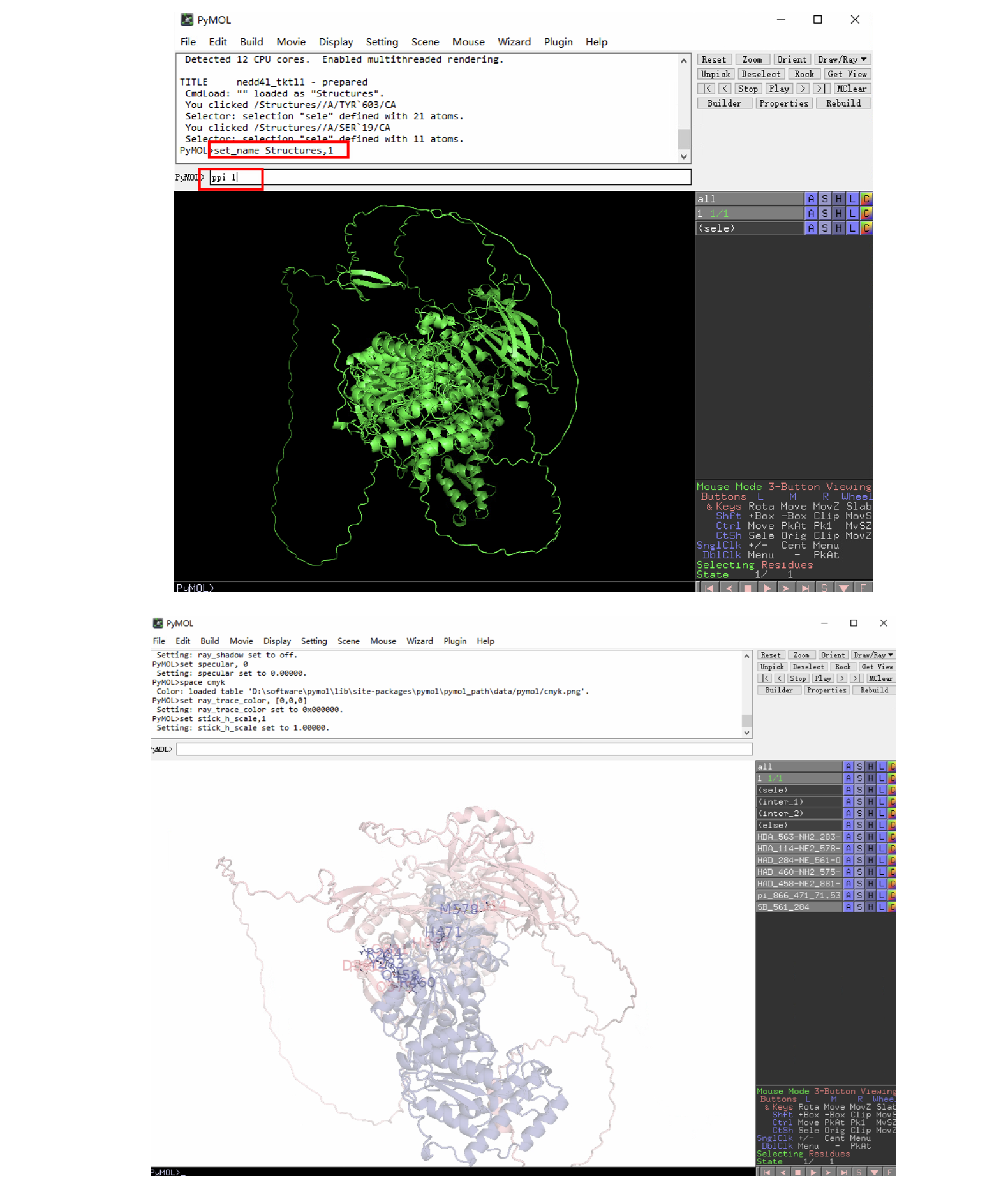
- 可视化操作,hide cartoon后,调整标签位置;show cartoon后,调整透明度大小,然后Draw出去就好了
hide cartoon
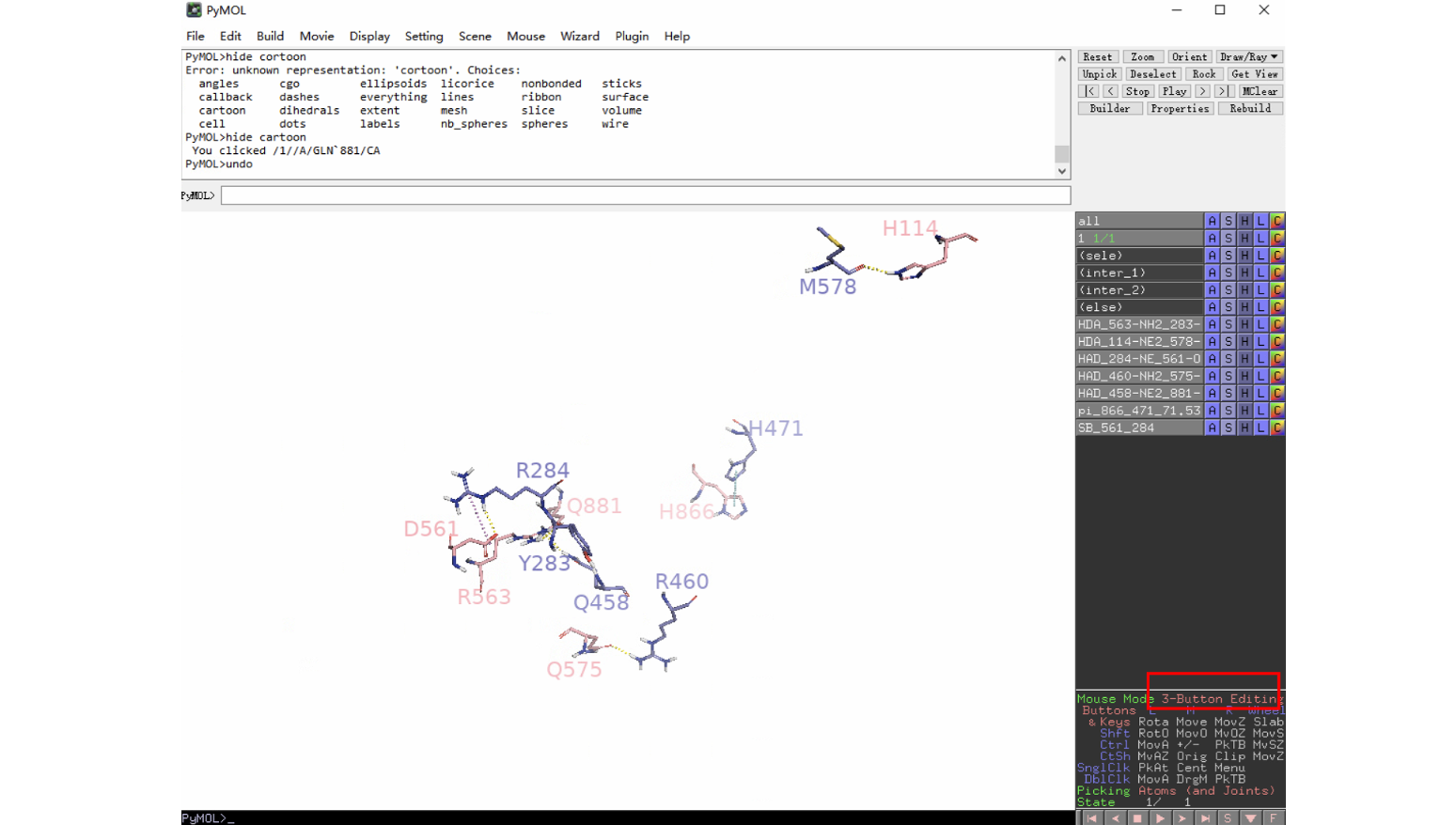
show cartoon
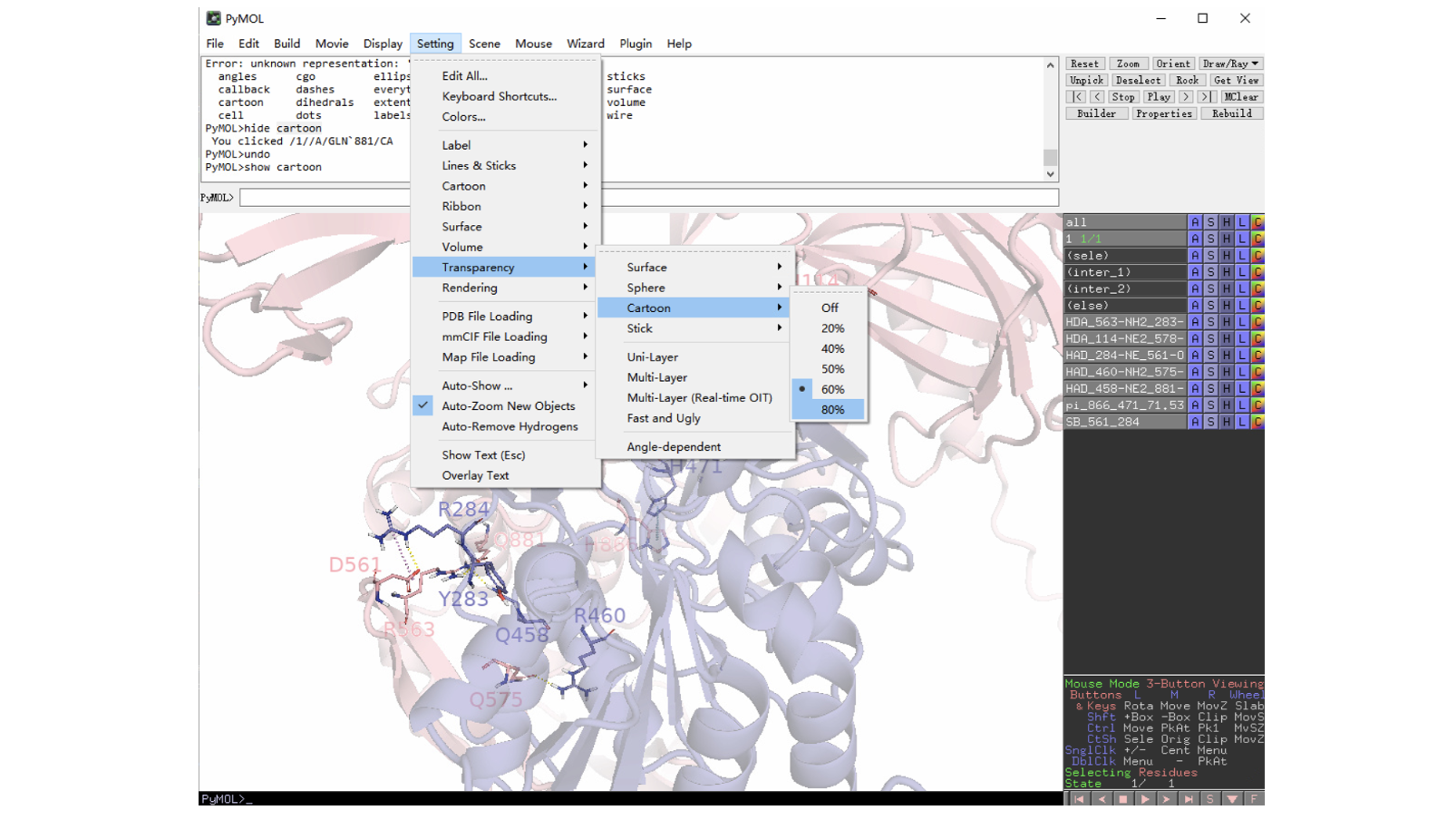
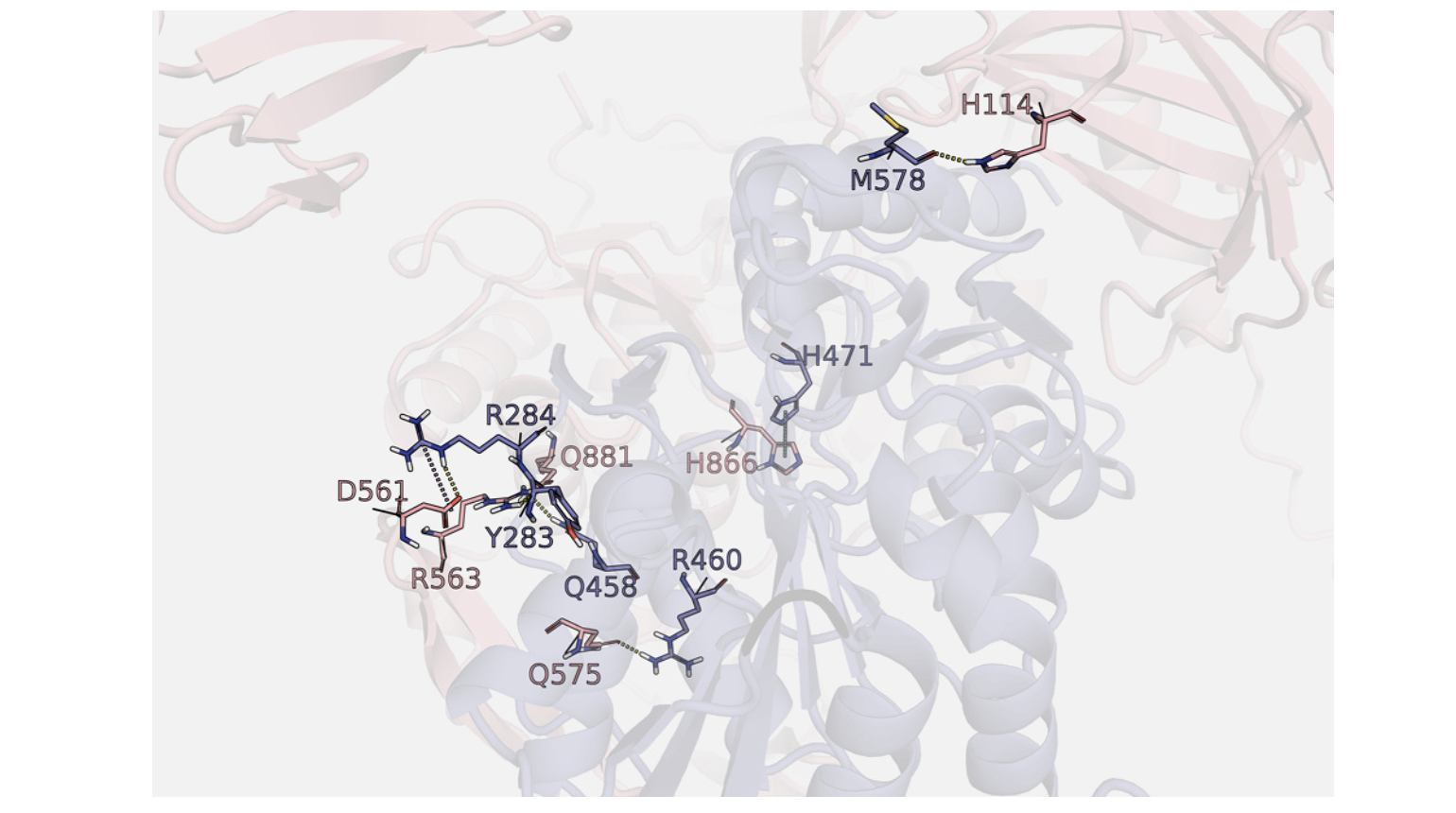
- hide sticks、hide labels后,调整cartoon透明度为0,获取整体的图。然后在进行组图就可以了
hide sticks
hide labels
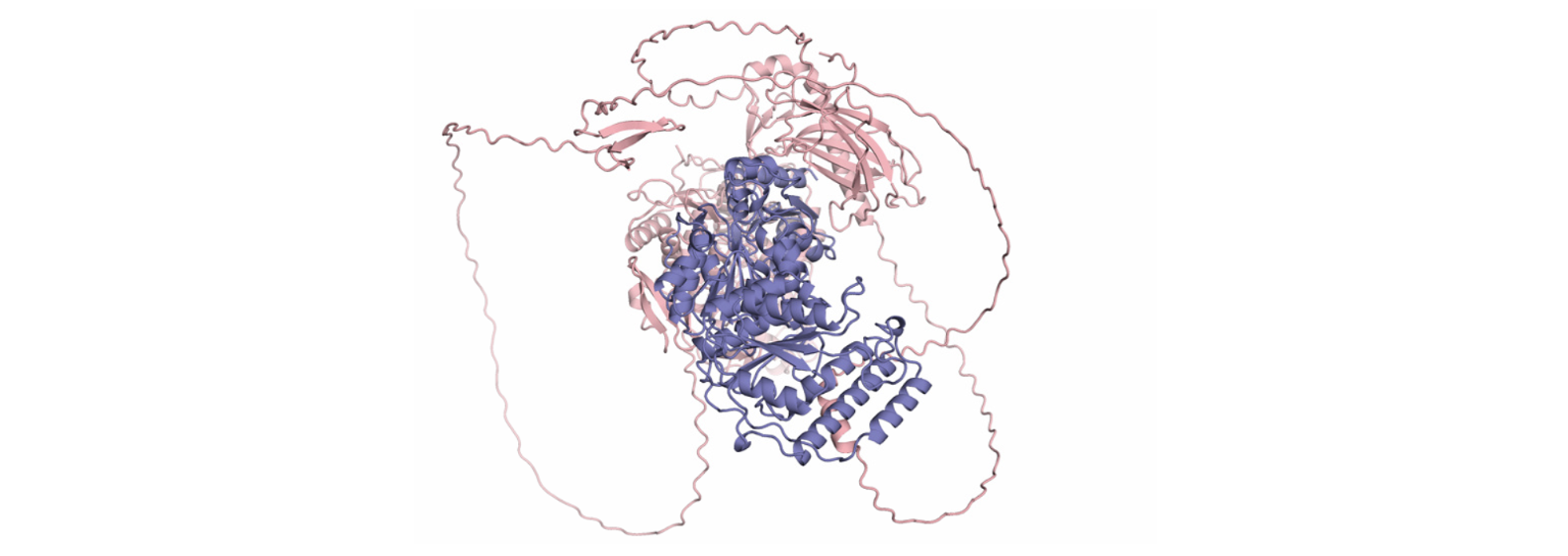
4.对接结合能计算
- 使用在线网站(https://rascar.science.uu.nl/prodigy/)计算模型的自由能,上传pdb文件,即经过Maestro进行结构优化后的文件
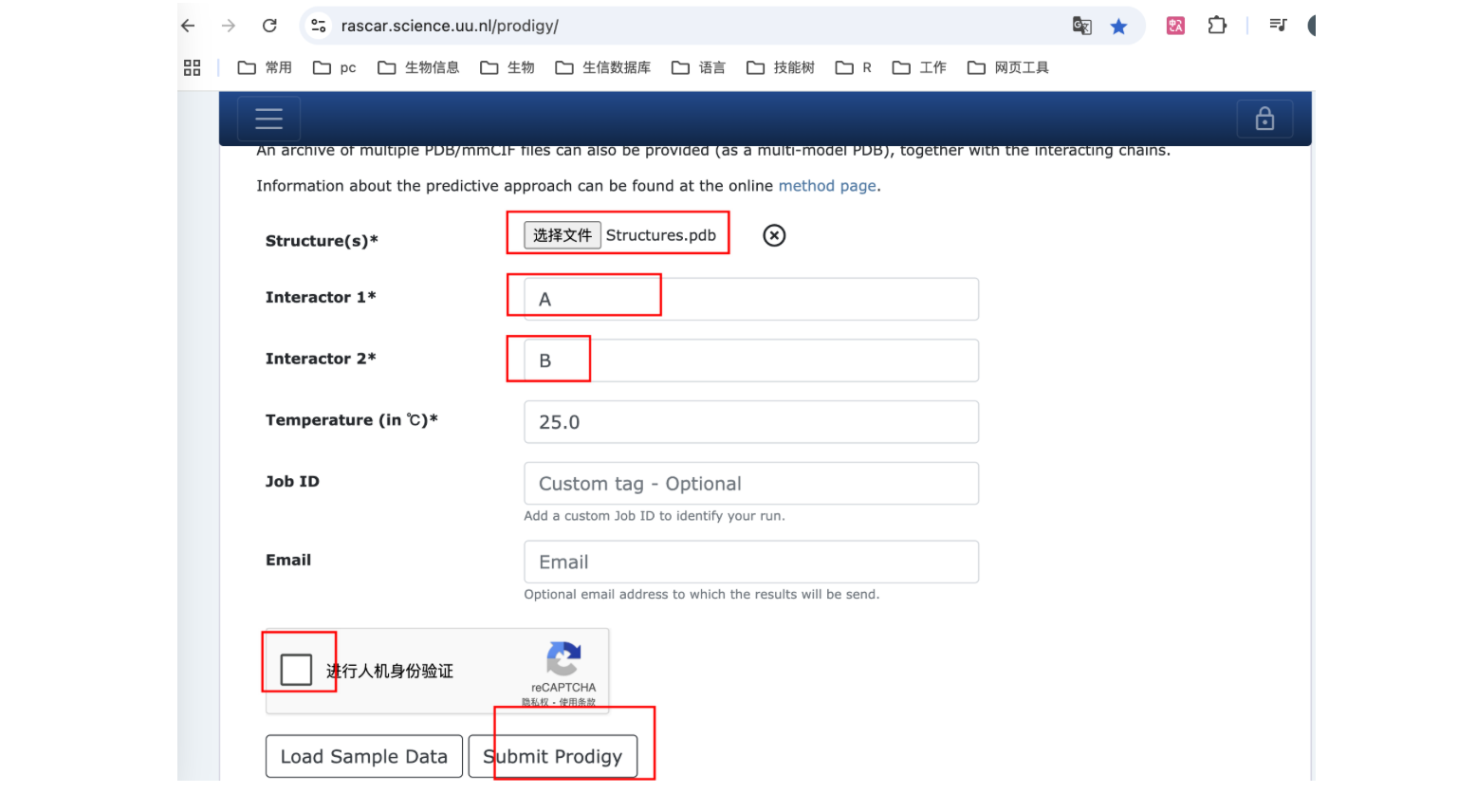
- 即可获取模型的自由能
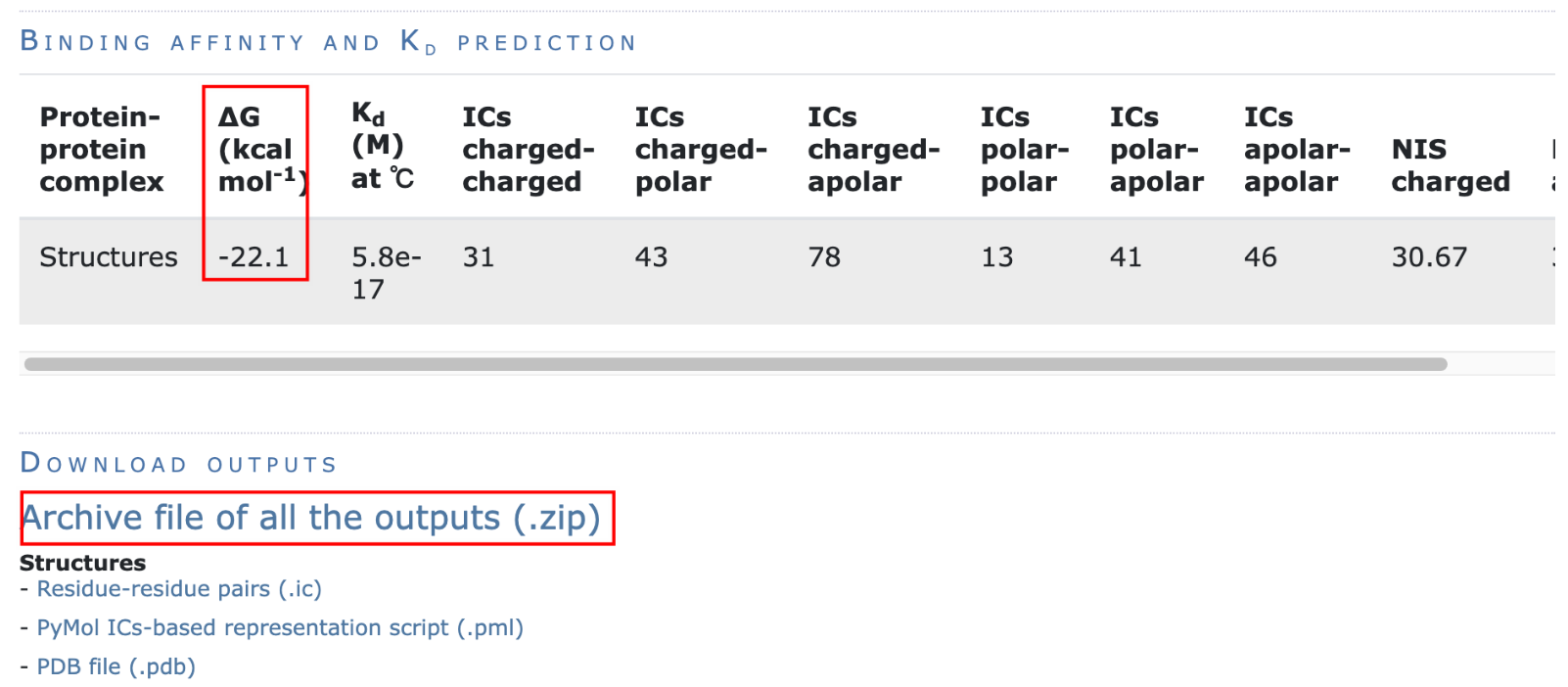
5.对接面积计算
- 使用在线网站(https://www.ebi.ac.uk/pdbe/pisa/)计算蛋白对接面积
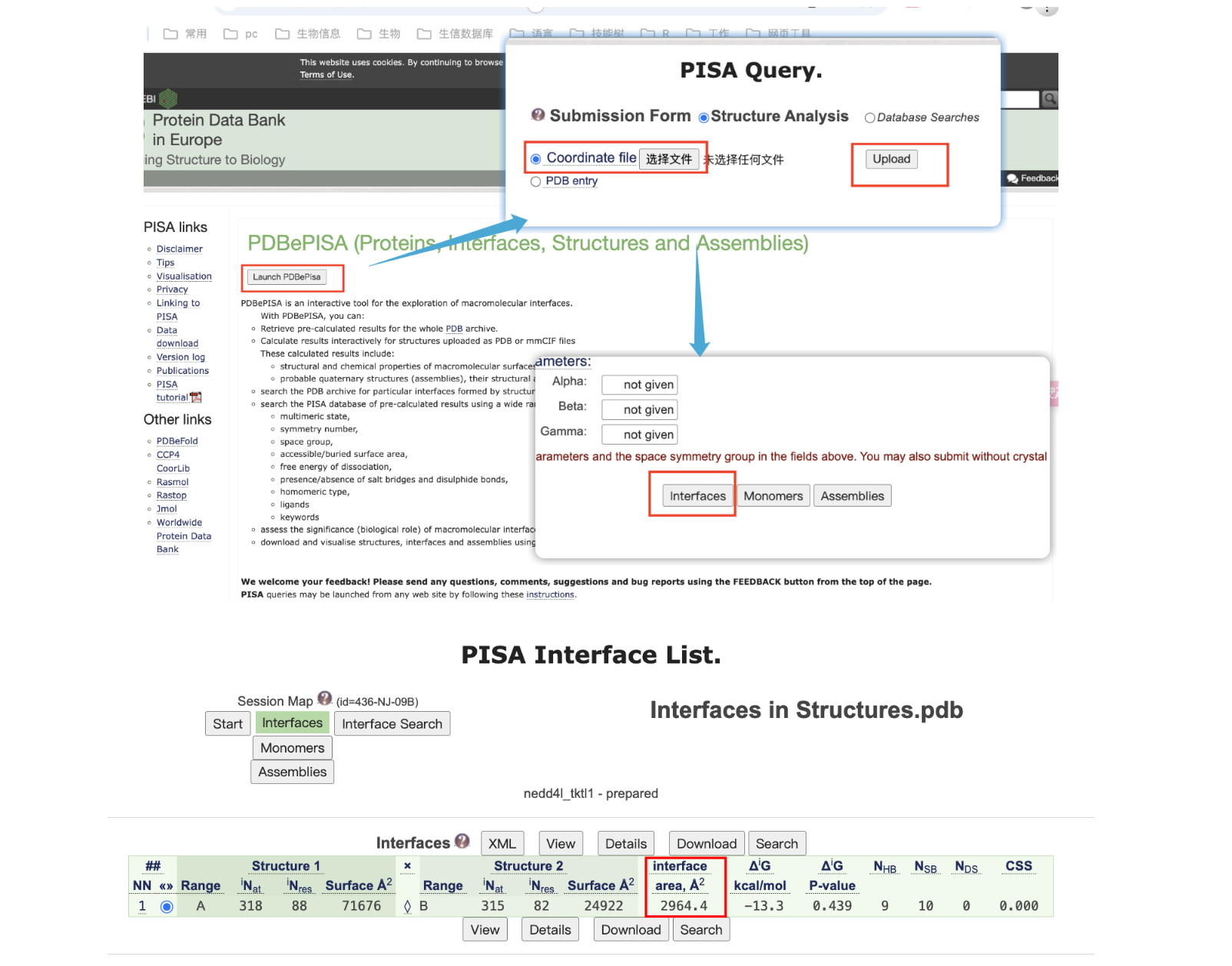
6.常见问题
- 辨析π-π stacking(芳香环之间的堆叠)、Salt bridge(盐桥)、Hydrogen bond(氢键)、Van der Waals 力(范德华力)

- 分子对接模型,其自由能一般多少可以认为对接效果好


📌 说明:
越负的值代表结合越稳定(放出更多能量)
不同软件(如 AutoDock, Glide, Vina)打分标准略有不同,但通常在这个范围附近
静态对接仅提供初步判断,真实结合能力还需考虑:
受体和配体柔性
溶剂效应
分子动力学(MD)模拟等
🔬 举个例子:
药物候选分子对靶标蛋白的对接结果是 -9.5 kcal/mol → 可能是高亲和性结合
某种天然产物对某酶的对接结果是 -6.2 kcal/mol → 有中等活性潜力
-3.8 kcal/mol → 通常被认为不够强或可忽略- 蛋白对接中什么是刚性对接、什么是柔性对接。使用alphafold对接和使用zdock、hdock对接有什么区别?
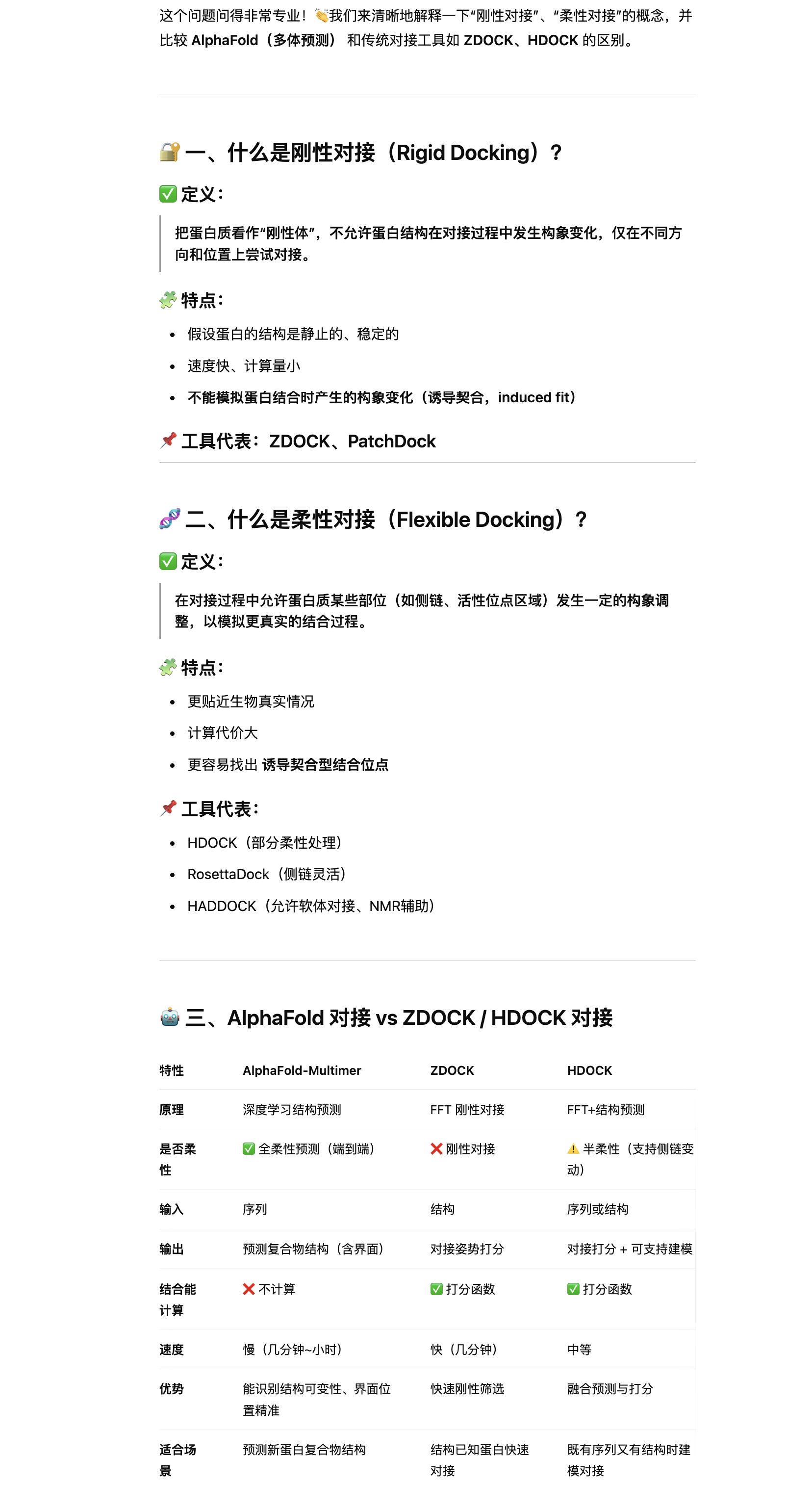
原创声明:本文系作者授权腾讯云开发者社区发表,未经许可,不得转载。
如有侵权,请联系 cloudcommunity@tencent.com 删除。
原创声明:本文系作者授权腾讯云开发者社区发表,未经许可,不得转载。
如有侵权,请联系 cloudcommunity@tencent.com 删除。
评论
登录后参与评论
推荐阅读
目录

